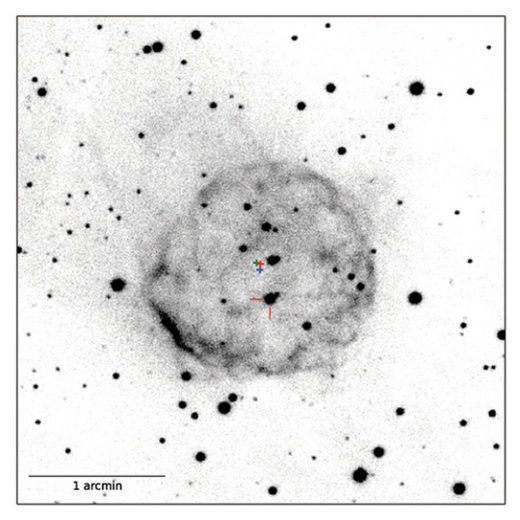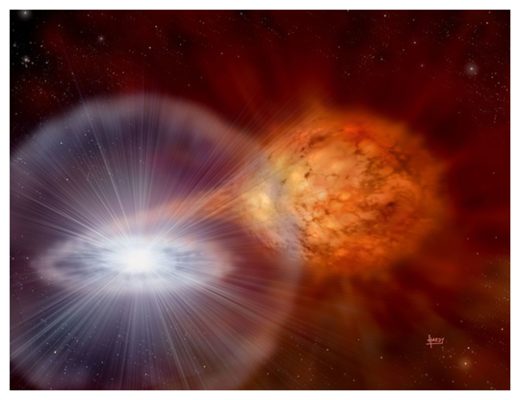
In 1437, Korean royal astronomers observed a new star appearing in the constellation Scorpius. "A guest star began to be seen between the second and third stars of Wei," they wrote in the Sejong Sillok, a chronicle of the reign of King Sejong who ruled Korea from 1418 to 1464. The star faded from sight after 14 days.
What the puzzled subjects of King Sejong witnessed was a classical nova - the outburst of a white dwarf in a close binary system when it collects sufficient hydrogen from its companion star.
In this scenario a white dwarf, normally hydrogen-poor, accumulates fresh gas on its surface until the bottom layers become deep and hot enough that hydrogen atoms begin to fuse. A runaway thermonuclear reaction ensues, turning the dwarf's thin surface layer into a shell-shaped hydrogen bomb.
But little is known about what happens to the binary system centuries after the white dwarf throws its tantrum. Astronomers think the system remains relatively unharmed and the gas transfer resumes, setting things in motion for another catastrophic event. Indeed, "recurrent novae" re-explode on observably short timescales.
A team led by Michael Shara (American Museum of Natural History) with help from Richard Stephenson (Durham University), a historian specializing in Asian astronomical records, followed the indications from the Sejong Sillok to look for the stellar system responsible for the guest star, now called Nova Scorpii 1437. "It was the best-located classical nova in over 2,000 years of records by Chinese, Korean and Japanese astronomers," Shara says. "We expected it to be faint, so a fairly precise location was essential if we were to have any realistic chance of recovering it."

There, they found the object they were looking for in an image taken in 1923 with the 24-inch Bruce Doublet telescope at the Harvard Observatory station in Arequipa, Peru. Slightly off target from their interpretation of the Korean records, Shara found a shell-shaped structure - presumably gas ejected by the explosion, which has been expanding for the last 580 years. Inside the shell, they found a cataclysmic variable that new imaging confirms is the origin of Nova Scorpii 1437. It's now simmering unsteadily with faint brightness - around 16th or 17th magnitude. They explain their findings in the August 31th Nature.
Finding the source of this nova is important because it allows astronomers to observe its state nearly 600 years later. Cataclysmic variables are a broad category of objects that includes novae, recurrent novae, nova-like variables, and dwarf novae, but this observation suggests that all of these could be a single type of object observed at different stages of life.
From the DASCH imagery, Shara's team saw that the progenitor of Nova 1437 has turned into a dwarf nova, showing smaller eruptions that brighten up the system. These occur when the white dwarf captures gas from its companion at a particularly fast rate. Such episodes appear in images taken in 1934, 1935, and 1942.
The authors propose a unified life cycle of cataclysmic variables: The white dwarf in a binary system goes nova, then returns to its unsteady state as a "nova-like variable" as gas transfer from the companion star gradually resumes. After a while it begins to collect gas more quickly, showing "dwarf-nova" characteristics, until it eventually explodes again, re-starting the cycle.
Guided by ancient records, Shara and his team intend to look for even older novae in modern images. They hope to find whether such systems can eventually become detached binaries, where the gas transfer to the white dwarf stops completely.
References:
Shara et al. "Proper-motion age dating of the progeny of Nova Scorpii ad 1437." Nature, August 2017.



Stars blow off as the load conveyed to the plasma pinch becomes too much for the pinch to retain in the Birkeland Sheath that we call the star surface.
It explodes, taking with it internal objects as well. These may become stars or remain planets if they retain an orbit. In larger stars, the event is much milder but the results are the same.
Stars seed the Galaxy with other stars. The Galactic Filaments gather energy all the time. A "micro-filament" is attached to every body in space. But that attachment may change, altering EMF conditions with these consequences!